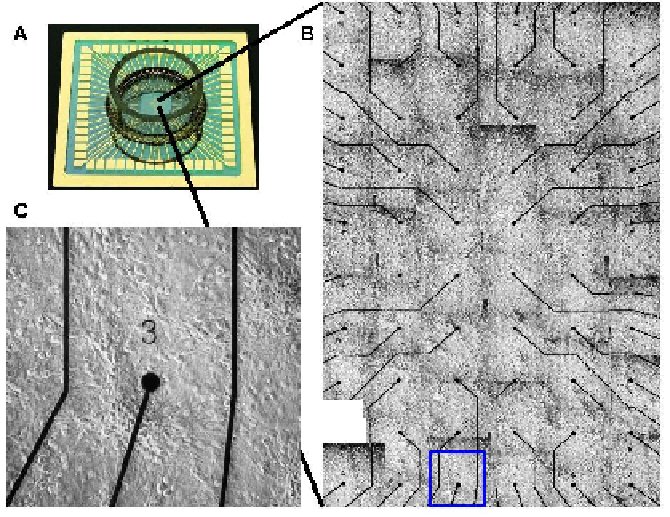Information Technology Reference
In-Depth Information
Fig. 12.1. Neuronal network on an electrode array. (A) A micro-electrode array on which a cultured
network is cultivated. The network is kept in a liquid medium inside the central well, where there
are 60 electrodes uncovered on the upper surface. Conductive leads connect the electrodes to
external pads on which amplifiers transfer the signals into a computer. Plate size is 4 cm in width
and the well diameter is 2 cm. (B) A photo montage of the central part of a cultured network
cultivated on a micro-electrode array with a rectangular 6 × 10 design. Distance between electrodes
is 500 µm. (C) Zoom-in on one electrode (marked by a blue rectangle in (B)). Electrode diameter is
30 µm.
12.3. Network Engineering
The laboratory process of culture generation enables great flexibility in the
patterning of the network. Several parameters may affect the final outcome of
network connectivity and cell organization. For example, the physical location of
the cells may be controlled by using advanced lithography methods. The plated
cells typically do not attach to the glass, and a "gluing" polymer (poly-D-lysine)
is first necessary to be evenly spread over the substrate before the placement of
the cells. Segev
et al
. (2002) have applied a lithography technique in which the
precise design of the polymer location is determined to the scale of micrometers.
This method enables the shaping of the culture into different sizes, such as
limited 2D or 1D cultures. In Raichman and Ben-Jacob (2008) cultures were
designed to take shape of a connected ring of four sub-networks by placing
poly(dimethylsiloxane)
H
PDMS) strips that act as barriers. Other novel methods

